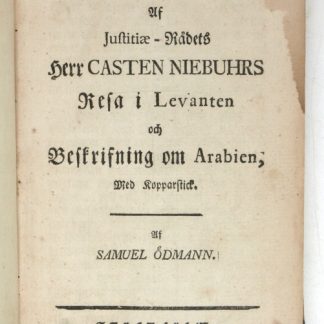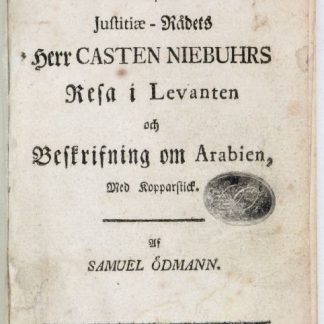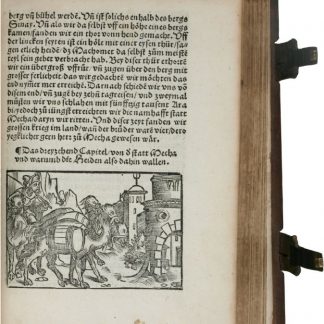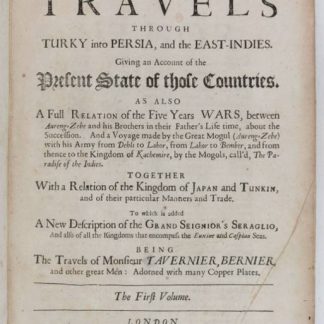With a map of the Gulf, a description of El-Katif, and the story of the pearl of the Imam of Muscat
Collections of travels through Turky into Persia, and the East-Indies. Giving an account of the present state of those countries.
Folio (214 x 310 mm). 6 parts in one vol. (18), 264 pp. (2), 214 pp. (2), 66 pp, (2). (12), 14, (4), 15-46, (4), 47-87, (1) pp. (6), 113, (1) pp. 154, (2) pp. With 17 full-page engr. plates, 13 folding plates, and numerous text illustrations (including plates of Arabian coins, the great name of Allah, and other Arabian inscriptions). Contemporary calf, spine rebacked.
€ 15.000,00
Rare first collected edition of Tavernier's works, profusely illustrated with a fold-out map of the Arabian Gulf, an unusual, large map of Japan, and a fold-out map of the Great Moghul. Comprising: 1) The First Book of Monsieur Taverner's [!] Persian Travels; 2) The Six Trabels of John Baptista Tavernier [...] Through Turky and Persia to the Indies: 3) A Relation of Japon; 4) A New and Particular Relation of the Kingdom of Tunquin; 5) A New Relation of the Inner-Part of the Grand Seignor's Seraglio; 6) The History of the Late Revolution of the Dominions of the Great Mogol. A rare and interesting account of Turkey, Persia, India, Japan, Tonkin, and Formosa. "The Persian Gulf is the most dangerous Gulf I know, by reason of the shallowness and sharp promontories that point out into Sea [...] The Merchant would be glad to find a way through the Coast of Arabia to get to Mascate [...] Elcatif a Sea Town in Arabia, where there is a fishery for Pearls that belong to the Emir of Elcatif" (pt. I, p. 95; "Qatif" being an oasis in Saudi Arabia). Chapter XI (p. 49) of the first part deals with the breeding and nature of camels; chapter III (p. 64) mentions a voyage to Mecca; chapter XXIII (p. 255) deals with the island of Ormus (with the map of the Arabian Gulf).
The second part begins with a discussion of Arabian currency and is illustrated with plates of Arabian coinage. The most important story is perhaps that of “The Imam of Muscat Pearl - That Surpassed in Beauty All Other Pearls in the World”. In chapter XVIII of book II, "Of Pearles and the places where to find them" (p. 145), Tavernier states: "In the first place, there is a Fishery for Pearls in the Persian Gulf, round about the Island of Bakren. It belongs to the King of Persia, and there is a strong Fort in it, Garrison'd with three hundred men." Tavernier then narrates: "There is a wondrous Pearl in the possession of an Arabian Prince, that took Mascate from the Portugals. He then call'd himself Imenhect Prince of Masscaté; being known before only by the name of Aceph Ben-Ali Prince of Norennaé. It is but a small Province, but it is the best of all in the Happy Arabia. Therein grow all things necessary for the life of man; particularly, delicate fruits, but more especially most excellent Grapes, which would make most incomparable Wine. This Prince has the most wonderful Pearl in the world, not so much for its bigness, for it weighs not above twelve Carats and one sixteenth, nor for its perfect roundness, but because it is so clear and so transparent that you may almost see through it. The Great Mogul offer'd him by a Banian forty thousand Crowns for his Pearl, but he would not accept it." The use of the phrase "clear and lustrous as to appear translucent" seem to indicate a white or colorless pearl, the most sought-after color in pearls, with an optimum of lustre and orient caused by the reflection and refraction of light, respectively. The surface quality of the pearl must be exceptional and almost blemish-free in order to characterize it as a specimen surpassing in beauty all other pearls in the world, at that time. The fact that the pearl was in the possession of the Imam of Muscat in the mid-17th century indicates without any doubt that the pearl originated in the most ancient pearl fishing grounds in the world, the Arabian Gulf, most probably in the kingdom of Oman itself, at its very doorstep - on the pearl banks situated closer to the country's shoreline in the Gulf or the Strait of Hormuz. Oyster bearing reefs were well distributed throughout the Gulf, but were greater in abundance on the Arabian side of the Gulf than the Persian one. The pearls are depicted on a plate opposite page 150: "Figure one is of a Pearl which the King of Persia bought at the Fishery of Catifa in Arabia. It cost him 32,000 Tomans, or 1,400,000 Livres of our Money, at forty-six Livres and six Deneers to a Toman. It is the fairest and most perfect Pearl that ever was yet found to this hour, having no defect".
Blackmer 1632. Wing T251A, T252, T253. Campbell (Japan) 28. Cox I, 275f. OCLC 6071990. Cf. Wilson 223. Howgego T14. Severin 104-113. Not in Atabey or Weber.










